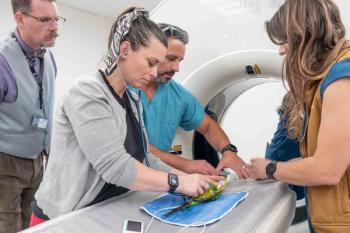
Ultrasonographic imaging of vomiting cats (Proceedings)
Why do they vomit? Because they can! What organ is the cause? What do we know about pancreatitis, inflammatory bowel disease and hepatobiliary conditions? This session will present a spectrum of cases, each providing a significant radiographic or ultrasound learning point.
Why do they vomit? Because they can! What organ is the cause? What do we know about pancreatitis, inflammatory bowel disease and hepatobiliary conditions? This session will present a spectrum of cases, each providing a significant radiographic or ultrasound learning point.
Radiology
The strengths of radiology include the evaluation of gas-filled structures, detection of mineralization and the assessment of liver size. Radiographs provide a global view of the abdomen and often provide a perspective unavailable from ultrasound.
Ultrasound
The strengths of radiology include the evaluation the internal architecture of intra-abdominal organs. As a real-time modality, ultrasound often gives instant gratification of mass lesions for organ or origin and key metastatic manifestations.
Philosophy
In cats we want to work as quickly as possible to expedite an answer before the cat tells us that "time is up"! I do almost all exams without sedation, because many of these patients are quite ill. Sedating a patient prolongs the imaging usually resulting in better quality imaging.
We always want to do a complete job and see everything. Keeping track of the "most important sites" helps prioritize a fast efficient examination. Don't dwell on a normal appearing liver at the expense of an incomplete study of the GI tract and pancreas.
First glance
Is there free peritoneal fluid? Maybe perform an abdominocentesis now to maximize efficiency. Is there concurrent pleural free fluid...this would be a bad sign! Bicavitary free fluid is a very poor prognosticator and strongly associated with bad diseases; FIP, bad cancer, severe heart failure. Concurrent pericardial free fluid (tricavitary free fluid) is highly associated with cardiomyopathy in its most severe manifestation.
Bright peritoneum
Hyperechoic peritoneal fat is often associated with free peritoneal fluid. Lacking free fluid, finding a site of hyperechoic peritoneal fat is a very important localizer for disease. Is the fat adjacent to a small intestinal bowel loop, pancreas or liver? This helps focus your examination towards a "more important" region or organ. On the other hand, not all-important lesions have an associated surrounding region of hyperechoic peritoneal fat.
Liver
Look for diffuse changes such as enlargement, changes in echogenicity and irregular shape. Cholangiohepatitis is very common and quite often occult. Elevated liver enzymes are enough clinical justification to perform a liver fna for cytology. The most common manifestation of cholangiohepatitis is a diffuse hypoechogenicity.
Clinical pathologists use the same term (hepatic lipidosis) to describe any fat infiltration in hepatocytes. All fat cats have a hyperechoic liver characterized by mild fat infiltration. This is a variation of normal and of no clinical concern. The clinical disease "hepatic lipidosis", with severe fat infiltration, is much more attenuating than the fat infiltration associated with normal obese cats. Make sure you read the cytology report carefully to find the "degree" of hepatic lipidosis. "Mild" is a normal variant, whilst severe is associated with liver failure, hyperbilirubinemia and clinical signs.
Dogs regenerate the liver with nodular changes. Benign nodular regeneration is very unusual in cats. Seeing nodules in the liver of cats is much more commonly associated with primary and metastatic cancer and demands additional testing, such as a fna of the nodule. An exception is the very characteristic echo pattern associated with biliary cyst adenoma. This lesion is both hyperechoic and hypoattenuating. The distal enhancement (=through transmission) artifact associated with a hyperechoic lesion is unique. This lesion is benign, although may continue to grow and have a mass-effect on the surrounding liver parenchyma.
Gall bladder
Gall bladder lesions, such as mucoceles, are very uncommon in cats. On the other hand, "sludge" (=inspissated bile) is more likely associated with hepatobiliary disease than in dogs. Seeing sludge is another reason to perform cytological or histological testing of the liver. Cholecystocentesis is reported to be more appropriate for obtaining a sample for culture, than performing a liver parenchyma fna, in cases of bacterial cholangiohepatitis. This procedure should be performed very carefully to avoid rupture or leakage. Some procedural advice includes; 1) go through liver parenchyma before entering the gall bladder and 2) drain the complete contents of the gall bladder during the procedure. Passing the needle through liver parenchyma before entering the gall bladder allows the liver to act as a patch on the gall bladder. Complete drainage of the gall bladder proves more time until the pressure increases in the lumen and leakage might occur.
Spleen
Primary splenic disease is less common in the dog than the cat. Diffuse splenomegaly, with normal-appearing parenchyma, is seen with mast cell neoplasia and lymphoma. Nodules are rare. Hemangiosarcoma is rare. Splenic enlargement, always a subjective finding, may dictate an fna of the parenchyma for cytological evaluation.
Pancreas
Pancreatitis is much more common than previously noted. Make sure that you can identify the left and right limbs in all cats. It is a "must see" organ in the vomiting cat. We commonly see echogenicity changes in the pancreas. On the other hand it is very difficult to be confident regarding the significance of mild size or echogenicity changes in a feline pancreas. An fna of the pancreas is relatively innocuous and may be very helpful to confirm a pancreatitis or diagnose pancreatic neoplasia.
Small intestines
Thickening of the small intestinal wall is very common cause of vomiting. This finding may be caused by inflammatory bowel disease or lymphoma. My threshold for wall thickness is 2.5mm. Mild changes (2.5 - 3.0mm) of wall thicknesses are often associated with significant inflammatory or neoplastic disease.
Unlike in dogs, the ileocolic junction is a "must see" body site to be evaluated. The ileocolic junction is a common predisposed site for lymphoma. The surrounding lymph nodes are another "must see" organ.
Lymph nodes
There are two groups of "must see" lymph nodes in the cat. The medial iliac lymph nodes, a "must see" in the dog, are not seen in most cats and a low priority site for neoplasia in the cat. The right colic lymph nodes are adjacent to the ileocolic junction. Typically 2-3mm in diameter, these are tiny nodes that we see in most cats. Enlargement to 5mm+ dictates additional testing such as fna fir cytological evaluation.
The jejunal lymph nodes are adjacent to the mesenteric root and are is seen on each side of the large mesenteric vessels. These nodes are elongated ovoid in shape and rarely more than 5mm in diameter, although commonly >1cm in length in normal cats.
Another "abdominal lymph node is the sternal lymph node group. Although in the cranial ventral thorax, the sternal lymph nodes drain the cranial abdomen and are common sites of metastasis from abdominal neoplasia. These lymph nodes are located immediately dorsal to the sternum at the level of the junction of the 2nd and 3rd sternebrae.
Kidney and urinary bladder
Stones may be associated pain in the ureter or bladder or infection in the kidney, ureter or bladder. Ureteral stones seem more common than 5 years ago, in spite of diet changes towards eliminating this disease. We see many stones causing regional ureteral dilation to the same diameter as the stone (2-5mm is common). Obstruction, pain associated with ureteral dilation, or ureteritis is common with these stones. Seeing free fluid adjacent to the ipsilateral kidney of a dilated ureter with a stone implies acute renal failure in that kidney, regardless of urine or serum values.
Mild to moderate pyelectasia is seen in kidneys with pyelonephritis. Urine testing for cytology and culture may be indicated for cats with dilated. Distorted renal pelvises, especially if there is peri-renal retroperitoneal free fluid.
I have been asked to image the abdomen of a vomiting cat to find a very firm/hard urinary bladder, small volume free peritoneal fluid adjacent to the bladder, mild bilateral hydronephrosis and hydroureter with small volume peri-renal retroperitoneal free fluid. Ultrasound seems like an inappropriate test for a "blocked cat"!
Heart
Never forget that cats in heart failure may have a cough that is misinterpreted by the owner as vomiting. This may be due to their violent abdominal effort during the cough episode. Whole body cat-o-grams are valuable for obtaining background information on the status of lungs and heart.
Cases
In the cases presented in this session we will begin with a discussion of the radiographs, followed by ultrasound images. Often the final diagnosis can be derived from the radiographs. On other cases the ultrasound is necessary for the diagnosis. Key roentgen signs will be discussed followed by development of a list of differentials. A new differential list will be provided after discussion of the sonographic findings.
Newsletter
From exam room tips to practice management insights, get trusted veterinary news delivered straight to your inbox—subscribe to dvm360.






